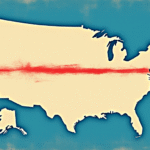Who is Jerome Powell?
Jerome Powell has been the Chair of the Federal Reserve (Fed) since February 2018. As the head of the central bank, he plays a crucial role in shaping U.S. monetary policy and influencing the nation’s economic trajectory.
Recent Fed Actions and Powell’s Statements
On June 25, Jerome Powell addressed the Senate Banking Committee, reiterating that he does not anticipate a “stagflation” scenario for the U.S. economy – a period of slow growth accompanied by higher inflation.
These comments came shortly after the Fed revised its growth projections for 2025 downward while raising inflation expectations for the current year.
Challenges Facing Policymakers
Powell acknowledged the difficulties policymakers face when adjusting interest rates amidst changing economic conditions. They might lower rates to stimulate a stagnant economy, but would likely keep them higher if inflation remains elevated.
When questioned about the “potential risks of stagflation,” Powell stated that it is not a base-case scenario for the world’s largest economy.
“We have warned about it, but honestly, it’s not something we are facing or expect to face. However, we are monitoring it,” he added.
Unpredictable Impact of Tariffs
Powell emphasized the difficulty in forecasting how new and unconventional tariffs imposed by President Donald Trump would affect inflation data.
“One reason it’s so challenging is that there really isn’t a modern precedent (…) We must be humble about our estimates, and we are very open to the possibility that the transmission through inflation may be less or more than we think,” Powell explained.
The Fed aims to take its time and make an informed decision as the situation unfolds, according to Powell.
J.P. Morgan’s Outlook
Analysts at JPMorgan Chase warn that U.S. trade policies will likely slow global economic growth and reignite inflation in the United States, increasing the risk of a potential recession by 40% in the second half of 2025.
They project U.S. GDP growth to be 1.3% for the year, falling short of the earlier 2% forecast.
“The stagflationary impulse from rising tariffs has been the driver behind our downward revision of GDP growth prospects for this year (…) We continue to see elevated recession risks,” the JPMorgan analysts stated.
Stagflation: A Concerning Mix
Stagflation, a worrisome combination of sluggish growth and persistent inflation, plagued the U.S. economy during the 1970s.
With a gloomy outlook on the U.S. dollar due to slowing growth, the Fed must carefully weigh its options.
Key Questions and Answers
- What is stagflation? Stagflation refers to a situation where an economy experiences slow growth and high inflation simultaneously.
- Why is predicting the impact of tariffs difficult? There is a lack of modern precedents for assessing how tariffs might affect inflation, making it challenging to forecast their impact accurately.
- What are J.P. Morgan’s concerns about U.S. trade policies? JPMorgan analysts warn that these policies could slow global economic growth, reignite inflation in the U.S., and increase the risk of a potential recession.
- How is Jerome Powell addressing these challenges? Powell acknowledges the difficulties and emphasizes the Fed’s commitment to monitoring economic conditions closely before making any interest rate adjustments.






